-
CATEGORY ::
- All Seeds /
- All Flower Seeds /
- All Milkweed Seeds



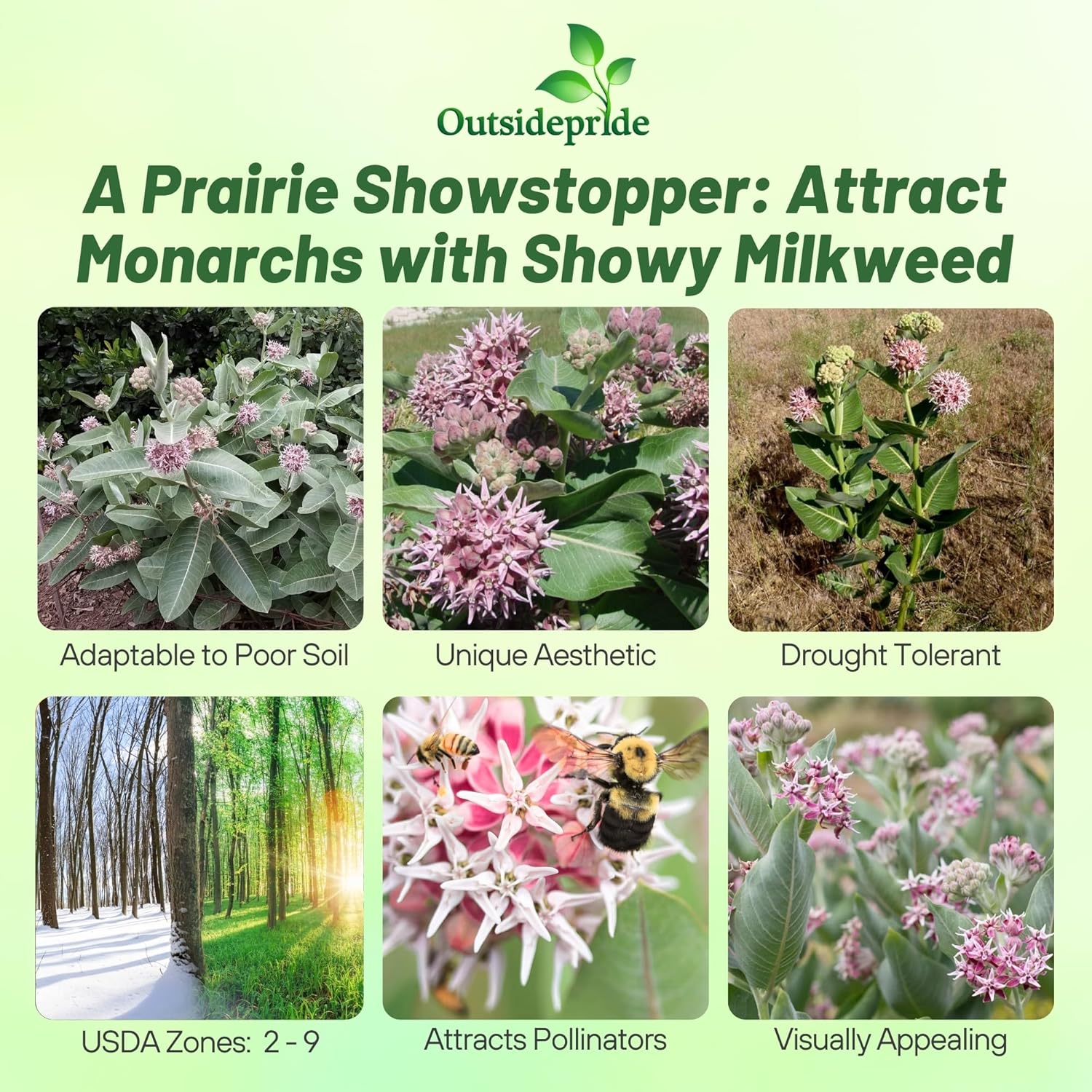
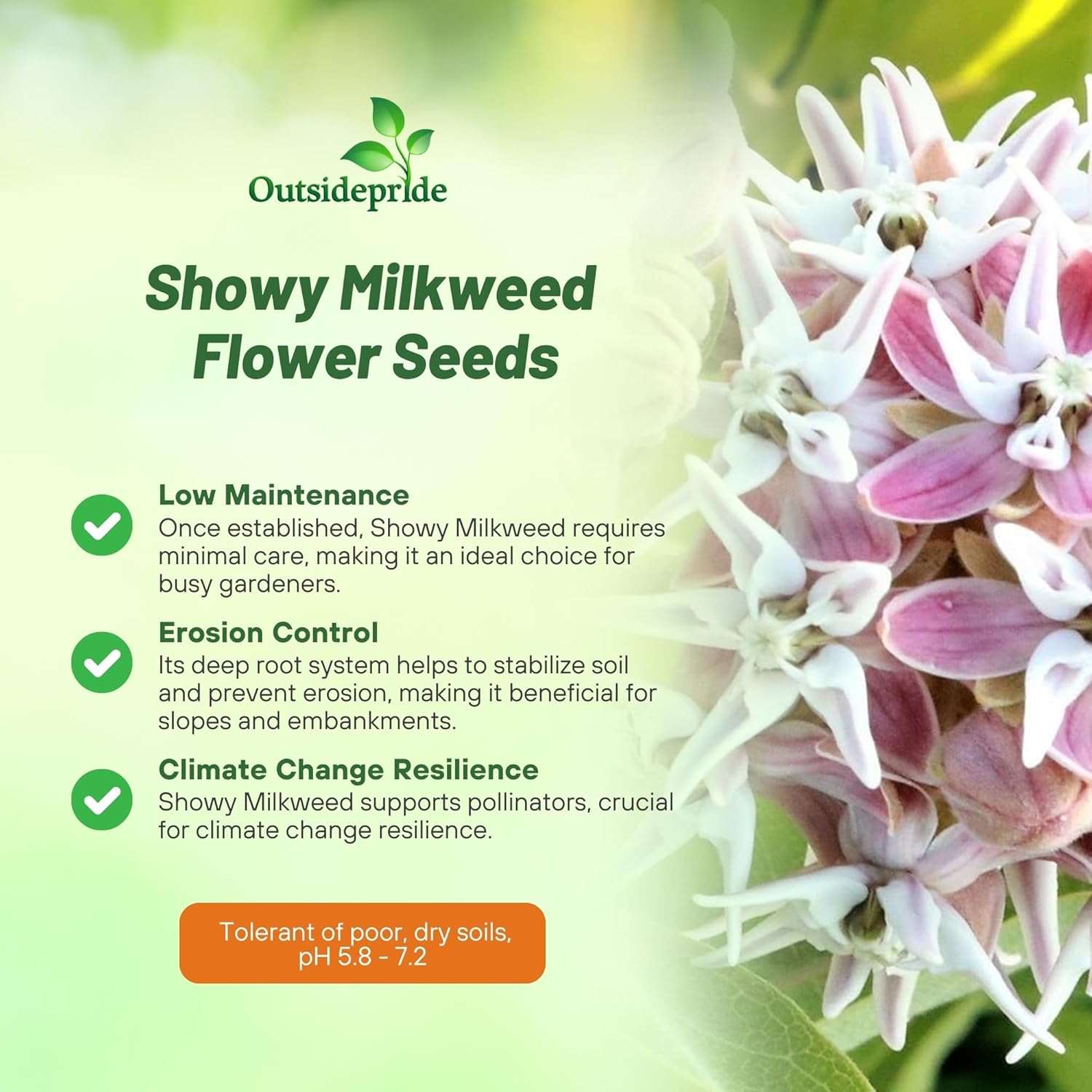
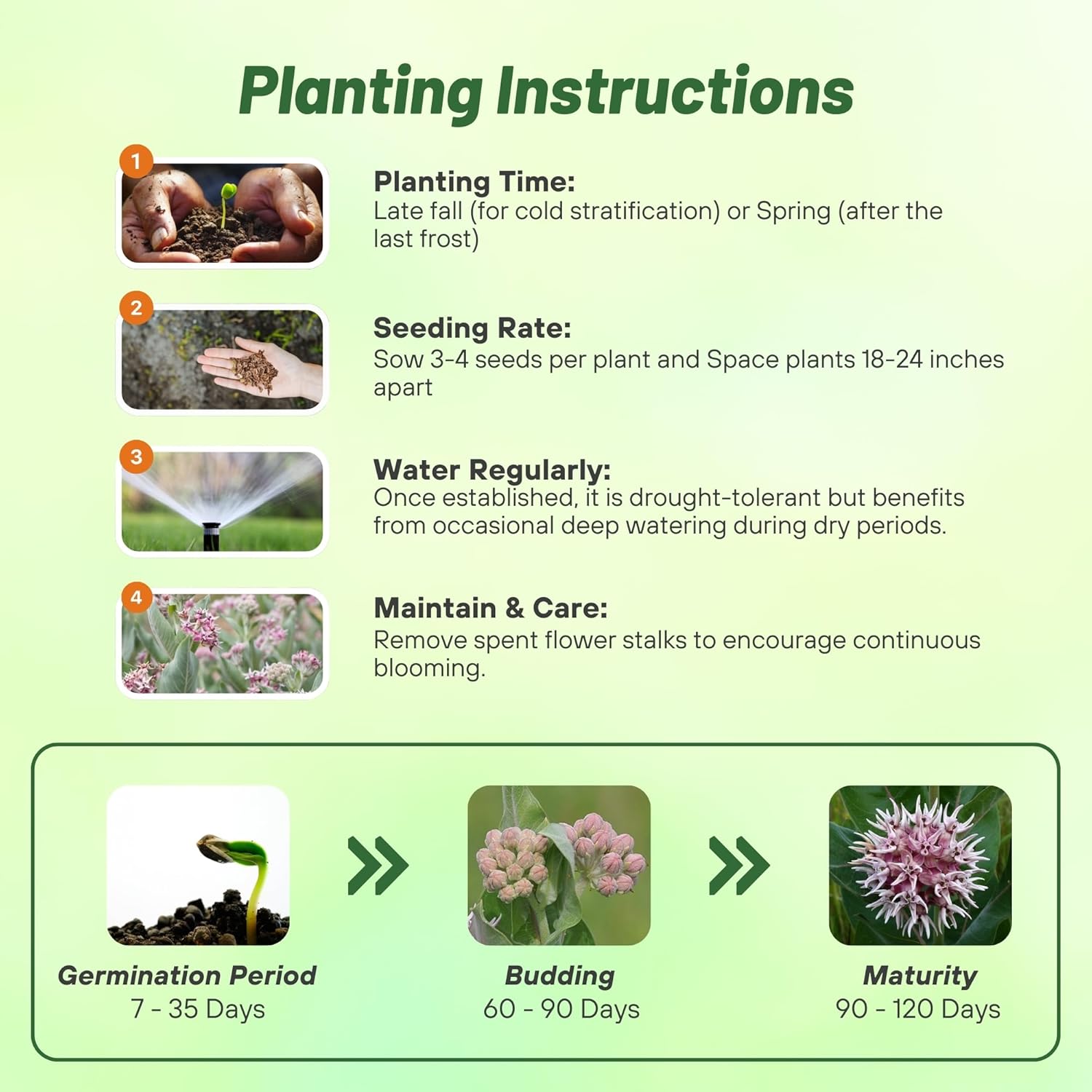


Milkweed Seeds - Showy
SEASON
Perennial
USDA ZONES
2 - 9
HEIGHT
40 inches
BLOOM SEASON
June - August
BLOOM COLOR
Purple-Pink
ENVIRONMENT
Full sun
SOIL TYPE
Tolerant of poor, dry soils, pH 5.8 - 7.2
DEER RESISTANT
Yes
HOUSE PLANT
No
SEASON
Perennial
USDA ZONES
3 - 9
HEIGHT
28 inches
BLOOM SEASON
Summer and fall
BLOOM COLOR
Orange
ENVIRONMENT
Full sun
SOIL TYPE
Sharply-drained, even rocky, pH 5.8 - 7.2
DEER RESISTANT
Yes
HOUSE PLANT
No
SEASON
Perennial
USDA ZONES
8 - 11
HEIGHT
24 - 32 inches
BLOOM SEASON
Summer and fall
BLOOM COLOR
Red
ENVIRONMENT
Full sun
SOIL TYPE
Moist, well-drained, pH 6.1 - 7.5
DEER RESISTANT
Yes
HOUSE PLANT
No
SEASON
Perennial
USDA ZONES
3 - 8
HEIGHT
28 inches
BLOOM SEASON
Summer and fall
BLOOM COLOR
Mix
ENVIRONMENT
Full sun
SOIL TYPE
Sharply-drained, even rocky, pH 5.8 - 7.2
DEER RESISTANT
Yes
HOUSE PLANT
No
SEASON
Perennial
USDA ZONES
3 - 8
HEIGHT
24 - 48 inches
BLOOM SEASON
Summer and fall
BLOOM COLOR
Rose
ENVIRONMENT
Full sun
SOIL TYPE
Consistently moist, pH 6.1 - 7.5
DEER RESISTANT
Yes
HOUSE PLANT
No
SEASON
Perennial
USDA ZONES
3 - 9
HEIGHT
36 - 48 inches
BLOOM SEASON
Summer and fall
BLOOM COLOR
White
ENVIRONMENT
Full sun
SOIL TYPE
Consistently moist, pH 6.1 - 7.5
DEER RESISTANT
Yes
HOUSE PLANT
No
SEASON
Perennial
USDA ZONES
3 - 8
HEIGHT
24 inches
BLOOM SEASON
June - August
BLOOM COLOR
Yellow
ENVIRONMENT
Full sun
SOIL TYPE
Deep, gritty sharply-drained soils. Tolerant of gritty, even rocky soils; pH 5.8 - 7.2
DEER RESISTANT
Yes
HOUSE PLANT
No
SEASON
Perennial
USDA ZONES
3 - 7
HEIGHT
48 inches
BLOOM SEASON
June - August
BLOOM COLOR
Pink
ENVIRONMENT
Full sun
SOIL TYPE
Tolerant of poor, dry soils, pH 5.8 - 7.2
DEER RESISTANT
Yes
HOUSE PLANT
No
About...
Showy Milkweed (Asclepias Speciosa) - This perennial plant can be easily established by sowing Asclepias seeds. It has up to 36 inch stems and large gray-green oval leaves that can be 5 inches in length. The flowers form on top of the stems and are rounded clusters of rosy-pink flowers.MORE MILKWEED OPTIONS
Planting Directions
TEMPERATURE
68F
AVERAGE GERM TIME
21 - 28 days
LIGHT REQUIRED
Yes
DEPTH
Surface sow seed, do not cover
SOWING RATE
3 - 4 seeds per plant
MOISTURE
Keep seeds moist until germination
PLANT SPACING
36 inches

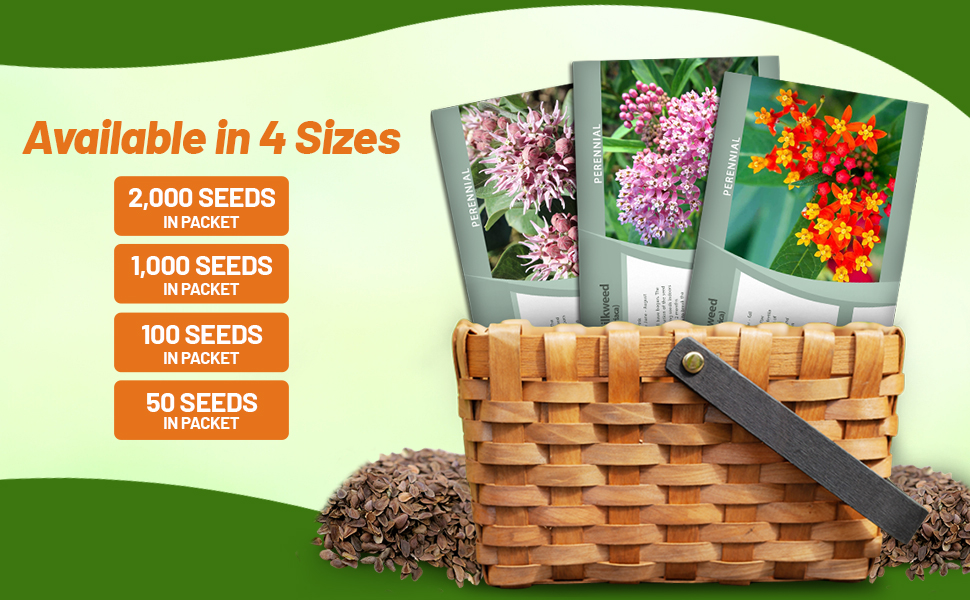



Showy Milkweed (Asclepias Speciosa) - This perennial plant can be easily established by sowing Asclepias seeds. It has up to 40 inch stems and large gray-green oval leaves that can be 5 inches in length. The flowers form on top of the stems and are rounded clusters of rosy-pink flowers. One plant can form a large clump by its spreading rhizomes. The Showy Milkweed plant, like its relative Butterfly Weed, prefers to be grown in full sun. It is quite drought tolerant after its second year of establishment as the root system is not well-established the first year after growing from flower seed. It can be found along ditches and roads as well as in moist sites of meadows and fields. Plants grow to 40 inches tall and have large, round clusters of pink flowers.
Showy Milkweed Asclepias is an ornamental native wildflower. It's perfect for home landscaping and use in the butterfly garden or prairie meadow, and it attracts hummingbirds as well. People have also used milkweed for fiber, food, and medicine all over the United States and southern Canada. Milkweeds (especially Asclepias speciosa) supply tough fibers for making cords and ropes, and for weaving a coarse cloth. It is a very versatile plant that is easily grown from flower seeds!
Growing Showy Milkweed from flower seed is very rewarding. It is appropriate to sow Asclepias seeds outdoors after the frosts of fall have begun. The cold, dormant planting will aid the germination of the seed in spring when temperatures warm. If sowing Milkweed seeds indoors or in a greenhouse, refrigerate the seed for 2 months before sowing. The cold treatment will help to break the dormancy of the seed.
Common Questions
What are some good companion plants for butterfly weed?
Perennial such as crocosmia, anthemis, kniphofia and agapanthus all go well with common milkweed.
Will butterfly weed attract other pollinators besides butterflies?
Yes, bees and hummingbirds also enjoy the butterfly weed plant.
How do I plant milkweed to attract butterflies?
If your goal is to attract monarch butterflies by planting common milkweed, establish a small milkweed patch with a minimum of six plants. Ensure there is a nearby water source for the butterflies; a birdbath or a large potting saucer filled with water will suffice. It's also beneficial to include other pollinator-friendly plants in a well-rounded butterfly garden.
Why not plant milkweed on the coast?
If you live in a coastal region or near a place where monarch butterflies overwinter, it is recommended to cultivate nectar plants like blazing star and bidens to aid the monarchs during their migration to and from the overwintering spot. Adult monarch butterflies rely on milkweed for reproduction, and the presence of milkweed misleads them into thinking it is a suitable location for breeding, thus disturbing their natural migration pattern.
Planting Directions
TEMPERATURE
60F
AVERAGE GERM TIME
28 - 42 days
LIGHT REQUIRED
Yes
DEPTH
Do not cover
SOWING RATE
2 - 4 seeds per plant
MOISTURE
Keep moist until germination
PLANT SPACING
24 inches

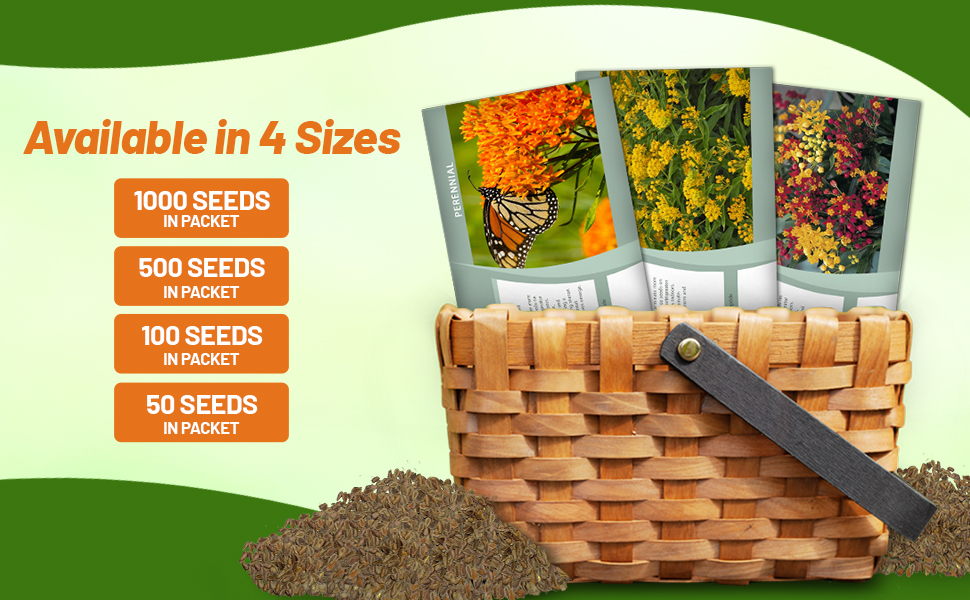

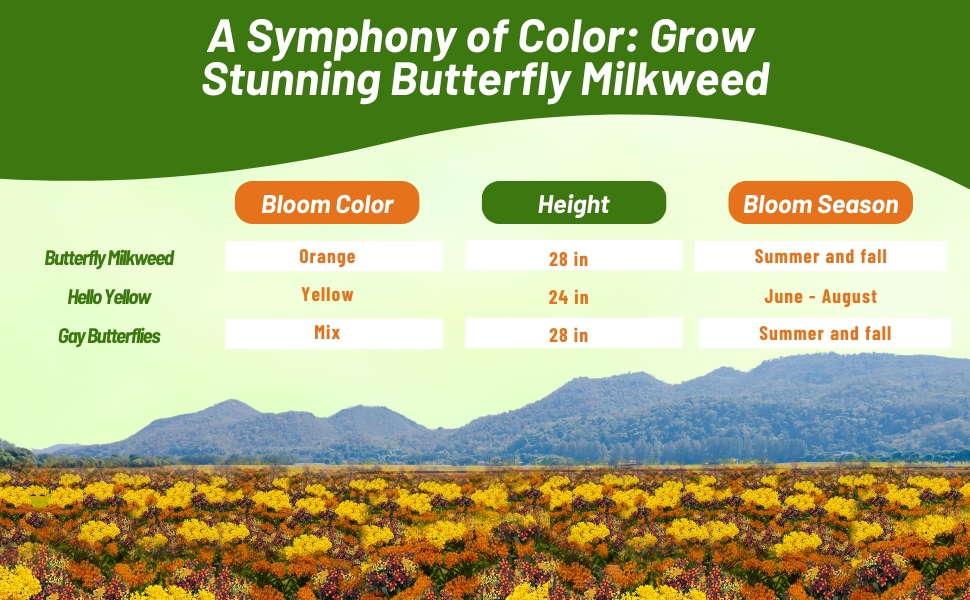

Butterfly Milkweed (Asclepias Tuberosa) - Butterfly Weed flower seed creates a beautiful butterfly-attracting plant. It has bright orange flower clusters that are flat and easy for butterflies to land on and drink the rich nectar. Being a member of the milkweed family, Butterfly Weed, will attract the monarch butterfly as well as other butterfly varieties. It is also resistant to drought.
Common Questions
What are some good companion plants for butterfly weed?
Perennial such as gayfeather, monarda, lavender, catmint and rudbeckia all work very well with butterfly weed.
Can I encourage more blooms on my butterfly weed plants?
Butterfly weed should bloom freely once mature (typically 3 years). If your plants are mature and you are still not blooming well, there could be a couple of factors at play. Make sure to water regularly until new growth starts (leaves and stems not just blooms) then you can decrease your watering frequency. Also, butterfly weed should NOT be fertilized, this can actually discourage blooming. If your plant is not receiving enough sunlight this can also hinder blooming, consider moving to a new location.
Do I need to prune my butterfly weed plants?
Butterfly weed does not need much pruning throughout the growing season, it can be cut back to the ground in late fall when leaves begin to yellow and stems turn brown. Do not mulch that can cause rot.
Will butterfly weed attract other pollinators besides butterflies?
Yes, bees and hummingbirds also enjoy the butterfly weed plant.
Can I use them as cut flowers?
Yes, these make an excellent quality cut flower for both floral arrangements and dried arrangements.
Why not plant milkweed on the coast?
If you live in a coastal region or near a place where monarch butterflies overwinter, it is recommended to cultivate nectar plants like blazing star and bidens to aid the monarchs during their migration to and from the overwintering spot. Adult monarch butterflies rely on milkweed for reproduction, and the presence of milkweed misleads them into thinking it is a suitable location for breeding, thus disturbing their natural migration pattern.
Planting Directions
TEMPERATURE
60F
AVERAGE GERM TIME
14 - 28 days
LIGHT REQUIRED
No
DEPTH
Do not cover
SOWING RATE
5 ounces per 1,000 square feet or 2 - 4 seeds per plant
MOISTURE
Keep seeds moist until germination
PLANT SPACING
24 inches
CARE & MAINTENANCE
Butterfly Weed...less

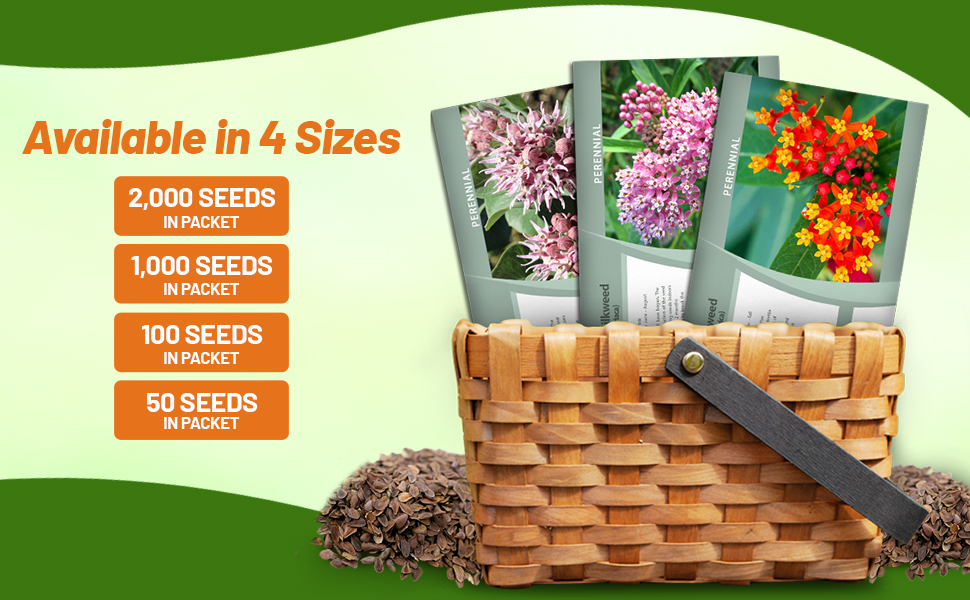



Tropical Milkweed (Asclepias Curassavica) - Here are more Tropical Milkweed seeds that produce tender evergreen perennials. Butterflies love this plant, and it provides a great food source for them! Commonly called Mexican Butterfly Weed, Blood Flower or Tropical Milkweed, these showy plants have blooms in the colors or red, orange and yellow.
Common Questions
How is blood flower used in the landscape?
Blood flower is a great addition to perennial borders, cottage gardens, and meadow gardens. For the best visual impact, its slender and airy growth style complements well when combined with other tall plants that have a relaxed growth pattern. Consider mixing it with other milkweeds, coneflowers, asters, Liatris, and ornamental grasses. While this plant has traditionally been popular in butterfly gardens, some experts now recommend using different native milkweed species instead.
Will deer eat blood flower?
No, blood flowers are typically avoided by deer.
Should I prune back my blood flower plants?
Yes, blood flowers can disrupt the natural migratory route of monarch butterflies, it is advisable to prevent them from seeding and spreading, particularly in regions without severe winters. Trim the plants at ground level during autumn to prevent seeding. In locations with mild winters, prune the blood flowers every few weeks to avoid year-round flowering.
Can I grow my plants in containers?
Yes, blood flowers are pretty easy to grow in a container. Use a fairly large, deep container to provide room for the tap root. Use regular commercial potting mix and blend with vermiculite or extra perlite to improve drainage. Plants will need watered regularly in containers.
Are blood flower plants a good attractant for the monarch butterfly?
Bloodflower is a host for the parasite Ophryocystis elektroscirrha, which can weaken monarch butterfly populations. Also, blood flowers may harm monarch butterflies in zones where the plant is perennial, because monarchs continue to feed on blood flower into winter, disturbing their migration.
What are some good companion plants for butterfly weed?
Perennial such as crocosmia, anthemis, kniphofia and agapanthus all go well with common milkweed.
Planting Directions
TEMPERATURE
60F
AVERAGE GERM TIME
28 - 42 days
LIGHT REQUIRED
Yes
DEPTH
Do not cover
SOWING RATE
2 - 4 seeds per plant
MOISTURE
Keep moist until germination
PLANT SPACING
24 inches

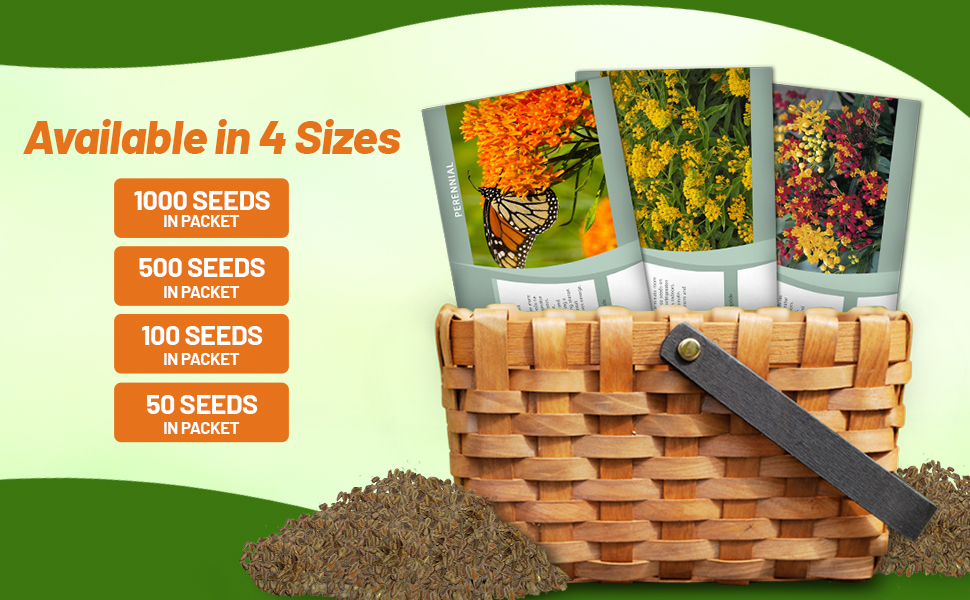

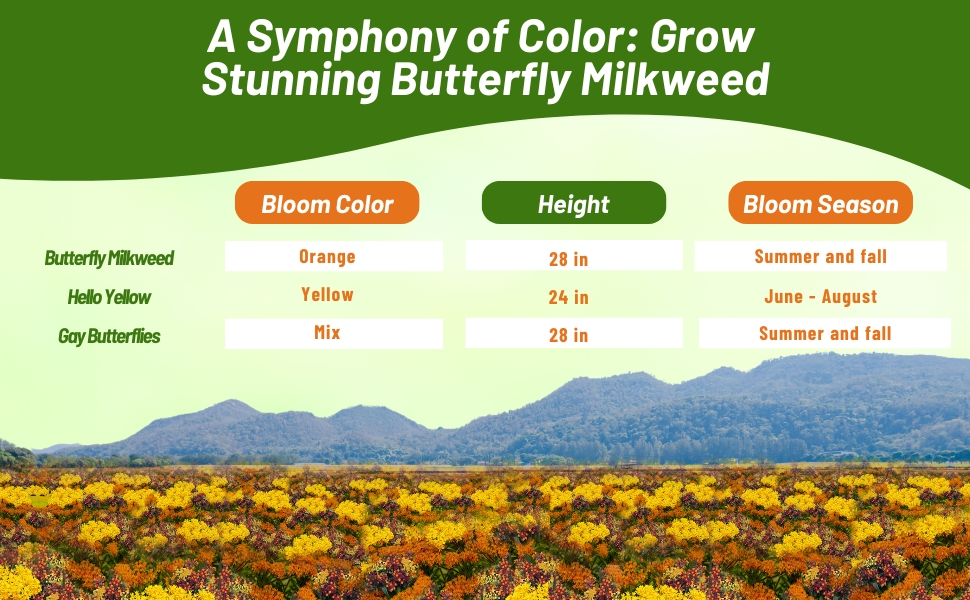

Butterfly Milkweed (Asclepias Tuberosa Gay Butterflies) - Start some Butterfly Weed seeds for both your garden and your neighbor's as well! Asclepias Gay Butterflies is not only an attractive drought tolerant perennial but it is also a wonderful food source for many beneficial insects. These Butterfly Weed giant flower heads are more than 5 inches across and in vivid shades of red, yellow, and orange. These vigorous Butterfly Weed plants can bloom from early summer until frost, and they flowers are also great for cutting.
Butterfly Weed AKA Milkweed is a trouble-free wonder in the sunny garden. It readily establishes from flower seed, and then it blooms unchecked through the most severe heat and drought. Winter-hardy as well, Asclepias Tuberosa Gay Butterflies returns for years to repeat its glorious show!
Many gardeners recommend a cold treatment to help Asclepias Tuberosa seeds germinate more quickly. To do this, dampen a paper towel, place the flower seeds on the towel and seal it in a ziploc bag. Place the bag in the refrigerator for 3 - 4 weeks. After the cold treatment, start the Butterfly Milkweed seeds indoors. Do not cover the flower seeds as they need light to germinate. Transplant the Butterfly Milkweed plants outdoors once temperatures are warm and plants have 4 - 5 leaves.
Common Questions
What are some good companion plants for butterfly weed?
Perennial such as gayfeather, monarda, lavender, catmint and rudbeckia all work very well with butterfly weed.
Can I encourage more blooms on my butterfly weed plants?
Butterfly weed should bloom freely once mature (typically 3 years). If your plants are mature and you are still not blooming well, there could be a couple of factors at play. Make sure to water regularly until new growth starts (leaves and stems not just blooms) then you can decrease your watering frequency. Also, butterfly weed should NOT be fertilized, this can actually discourage blooming. If your plant is not receiving enough sunlight this can also hinder blooming, consider moving to a new location.
Do I need to prune my butterfly weed plants?
Butterfly weed does not need much pruning throughout the growing season, it can be cut back to the ground in late fall when leaves begin to yellow and stems turn brown. Do not mulch that can cause rot.
Will butterfly weed attract other pollinators besides butterflies?
Yes, bees and hummingbirds also enjoy the butterfly weed plant.
Can I use them as cut flowers?
Yes, these make an excellent quality cut flower for both floral arrangements and dried arrangements.
Why not plant milkweed on the coast?
If you live in a coastal region or near a place where monarch butterflies overwinter, it is recommended to cultivate nectar plants like blazing star and bidens to aid the monarchs during their migration to and from the overwintering spot. Adult monarch butterflies rely on milkweed for reproduction, and the presence of milkweed misleads them into thinking it is a suitable location for breeding, thus disturbing their natural migration pattern.
Planting Directions
TEMPERATURE
40F
AVERAGE GERM TIME
21 - 28 days
LIGHT REQUIRED
No
DEPTH
Do not cover
SOWING RATE
4 seeds per plant
MOISTURE
Keep moist until germination
PLANT SPACING
24 inches
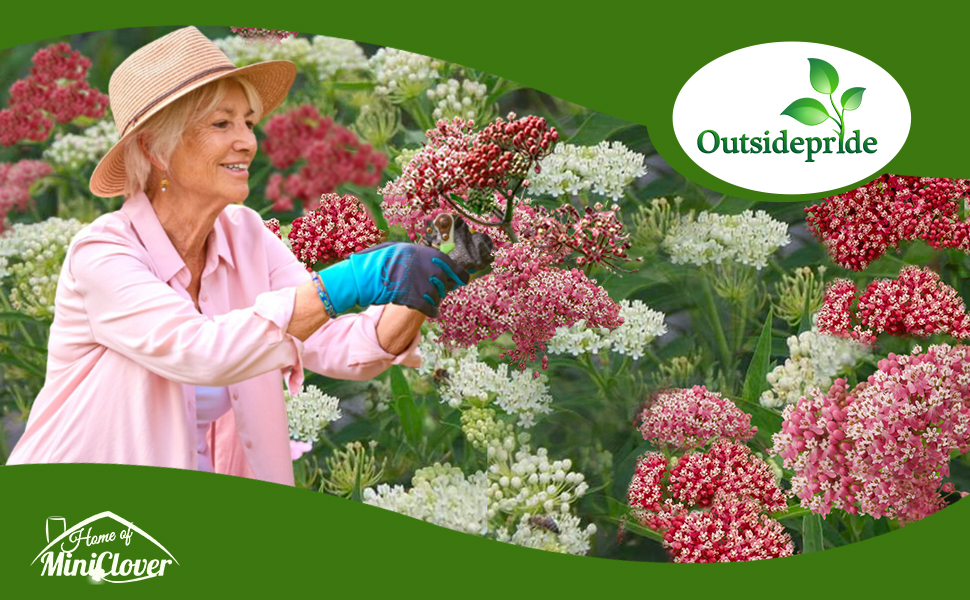
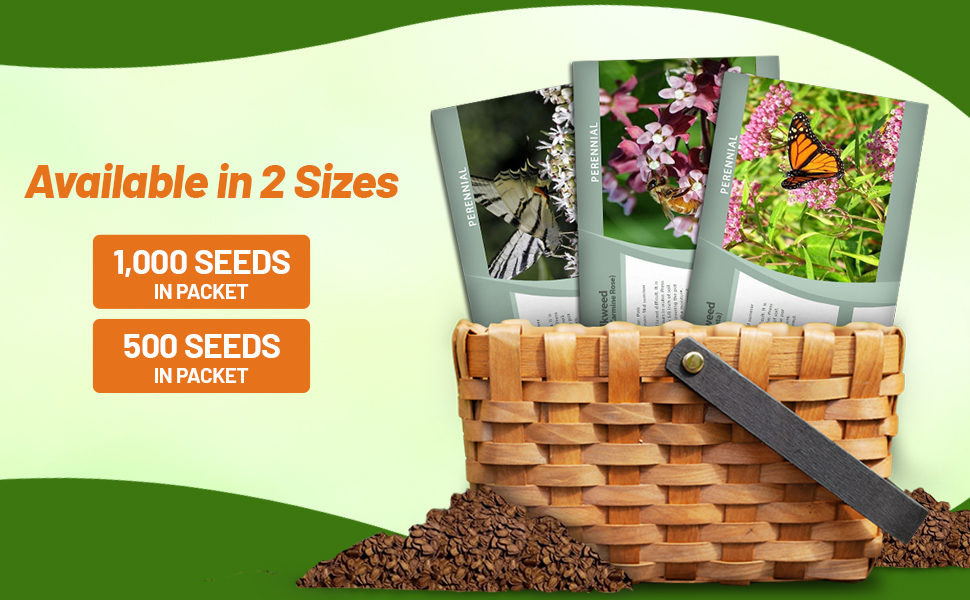

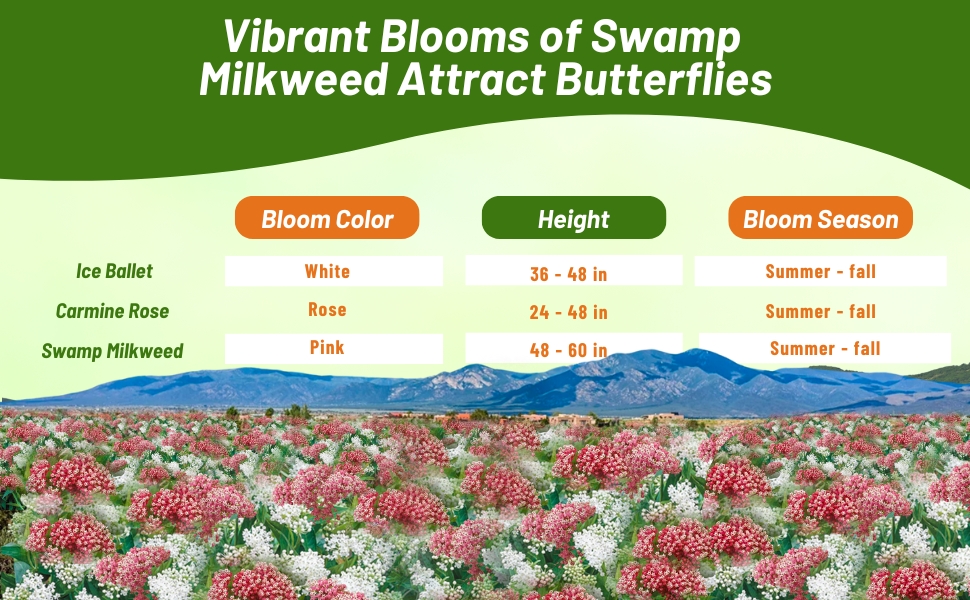
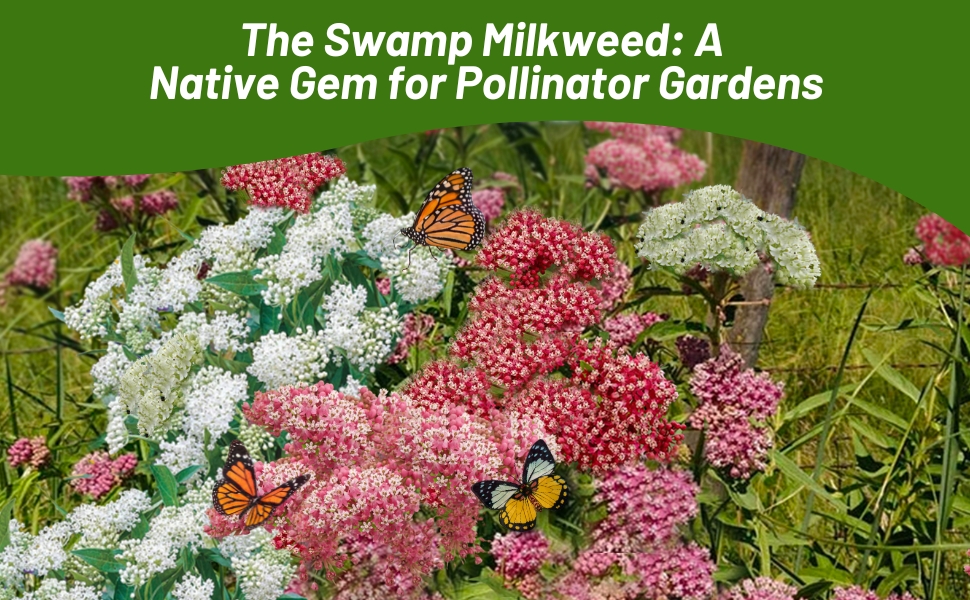
Swamp Milkweed (Asclepias Incarnata Carmine - Rose) - This cousin of Butterfly Weed known as Swamp Milkweed blooms the first year from flower seed and tolerates heat, humidity, and even drought! Asclepias Incarnata flowers are fragrant, colorful, and carefree! Growing Asclepias flower seeds is so rewarding knowing that these plants will soon be providing a food source for beneficial insects.
Common Questions
Is swamp milkweed invasive?
When grown in its natural habitat in the eastern U.S. and Canada, swamp milkweed is not considered invasive. However, it does tend to spread, so if this is a worry, consider planting it in a container or a spacious planter.
Should you deadhead swamp milkweed?
Removing spent flowers is not necessary but can be done for. neater appearance and it can prolong the bloom.
Why isn’t my swamp milkweed blooming?
If your swamp milkweed is not blooming, it might be due to the plant's young age. Milkweed may not produce flowers in its initial year as it focuses on root development. Additionally, an abundance of nitrogen in the soil, like runoff from a fertilized lawn, can hinder blooming. Also, plants experiencing drought, heat stress or not enough sunlight will also fail to blossom.
Can I grow my plants in containers?
Yes, swamp milkweed is pretty easy to grow in a container. Use a container at least 14 inches in diameter with good drainage holes. Terra cotta works great due to its heavier weight. Use regular commercial potting mix and blend with vermiculite or extra perlite to improve drainage. Plants will need watered regularly in containers. Re-pot when roots start to grow out of drainage holes.
Planting Directions
TEMPERATURE
40F for 2 - 3 weeks; followed by 68 - 72F
AVERAGE GERM TIME
21 - 28 days
LIGHT REQUIRED
No
DEPTH
Do not cover
SOWING RATE
4 seeds per plant
MOISTURE
Keep moist until germination
PLANT SPACING
24 inches
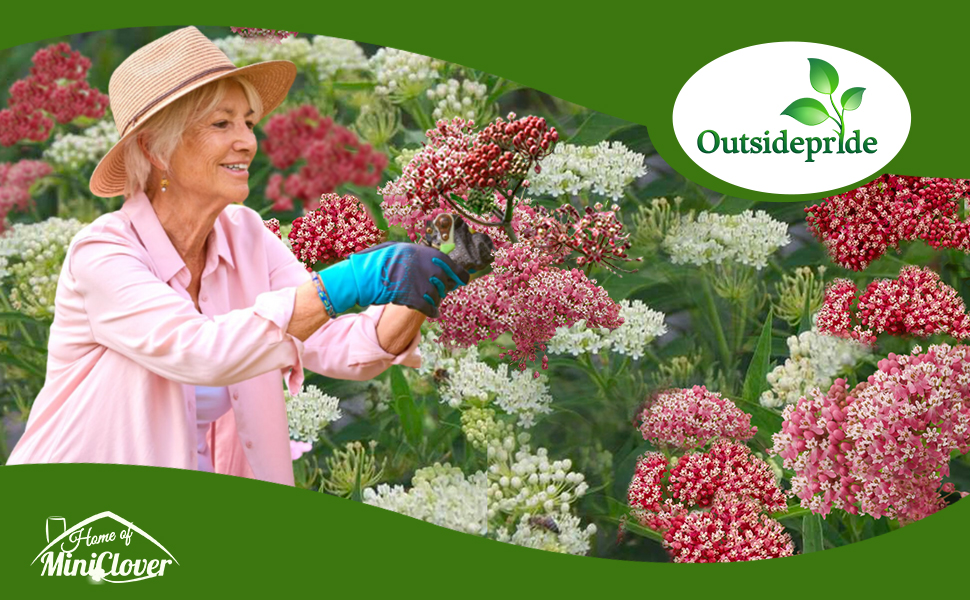
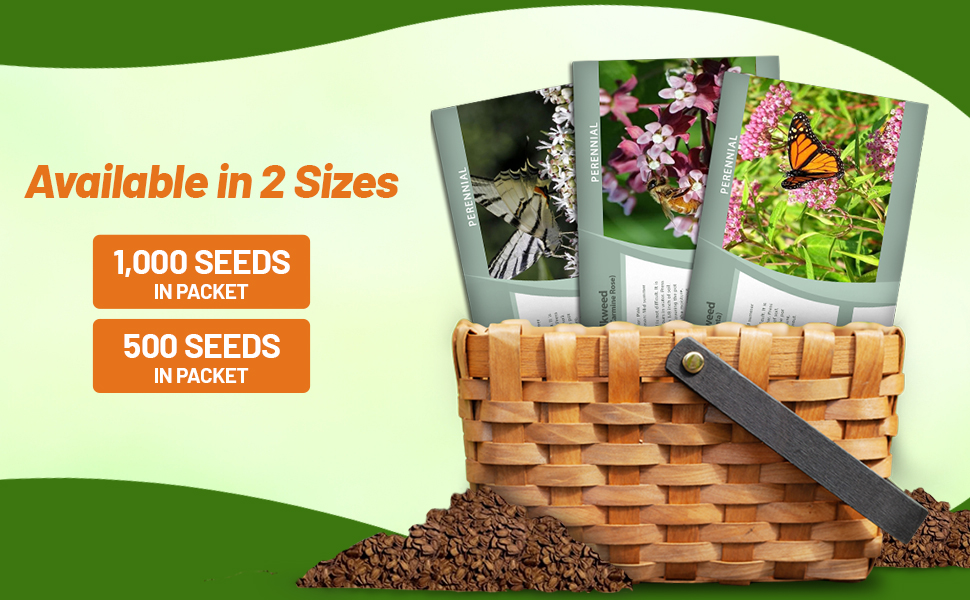

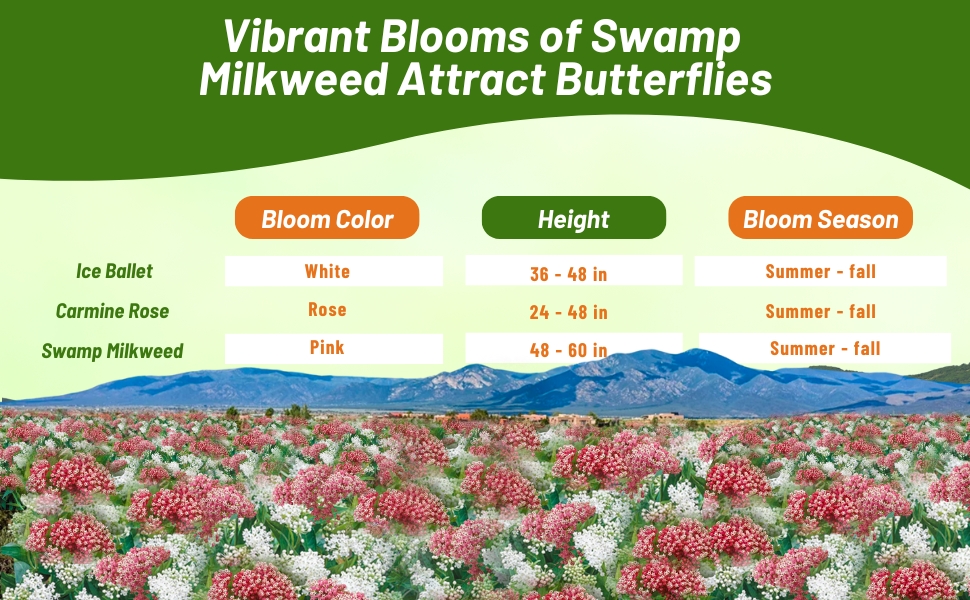
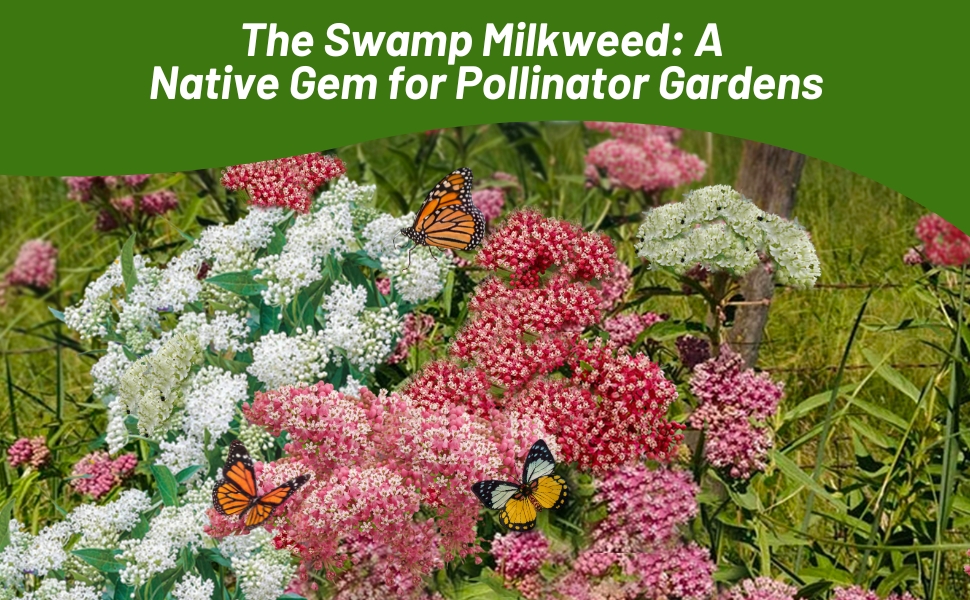
Swamp Milkweed (Asclepias Incarnata White) - Asclepias Incarnata Ice Ballet is a marvelous long-blooming, bright white cousin of Butterfly Weed. It readily establishes from Asclepias flower seeds, and it produces clear white flowers and dark green foliage. Flowers are long lasting and bloom early summer and into the fall depending on the weather. The flowers, which are heavily laden with nectar and pollen, are particularly attractive to hummingbirds, butterflies, bees, and other beneficial insects.
Common Questions
Is swamp milkweed invasive?
When grown in its natural habitat in the eastern U.S. and Canada, swamp milkweed is not considered invasive. However, it does tend to spread, so if this is a worry, consider planting it in a container or a spacious planter.
Should you deadhead swamp milkweed?
Removing spent flowers is not necessary but can be done for. neater appearance and it can prolong the bloom.
Why isn’t my swamp milkweed blooming?
If your swamp milkweed is not blooming, it might be due to the plant's young age. Milkweed may not produce flowers in its initial year as it focuses on root development. Additionally, an abundance of nitrogen in the soil, like runoff from a fertilized lawn, can hinder blooming. Also, plants experiencing drought, heat stress or not enough sunlight will also fail to blossom.
Can I grow my plants in containers?
Yes, swamp milkweed is pretty easy to grow in a container. Use a container at least 14 inches in diameter with good drainage holes. Terra cotta works great due to its heavier weight. Use regular commercial potting mix and blend with vermiculite or extra perlite to improve drainage. Plants will need watered regularly in containers. Re-pot when roots start to grow out of drainage holes.
Planting Directions
TEMPERATURE
60F
AVERAGE GERM TIME
28 - 42 days
LIGHT REQUIRED
Yes
DEPTH
Do not cover
SOWING RATE
2 seeds per plant
MOISTURE
Keep seed moist until germination
PLANT SPACING
24 inches

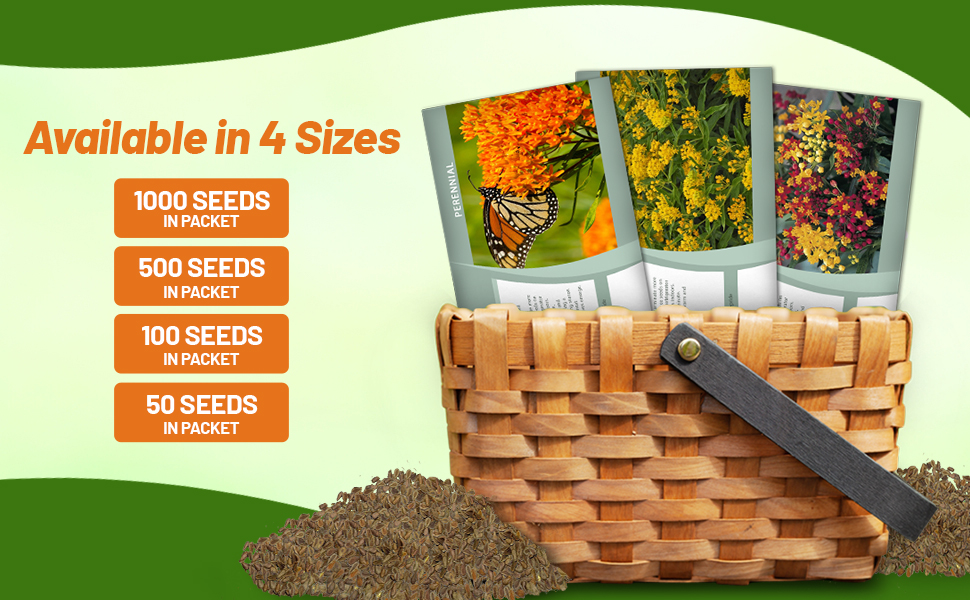

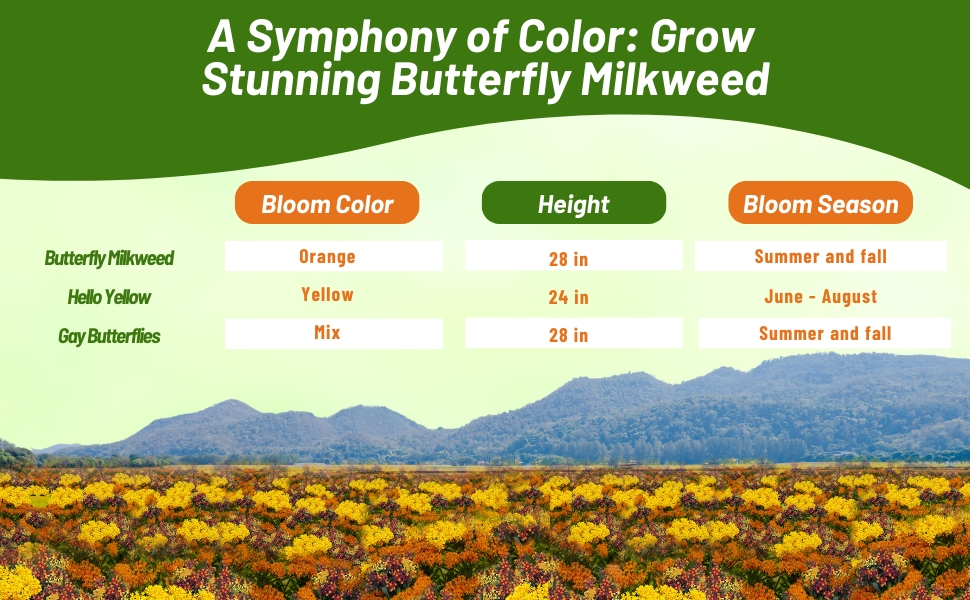

Butterfly Milkweed (Asclepias Tuberosa Hello Yellow) - Starting Butterfly Weed seeds is so rewarding, and soon this treasured drought tolerant perennial will have many visitors! Hello Yellow Butterfly Weed produces many golden yellow, flat-topped flower clusters in early June which will last for months. Green pods full of flower seeds with silky white hairs follow the flowers.
Common Questions
What are some good companion plants for butterfly weed?
Perennial such as gayfeather, monarda, lavender, catmint and rudbeckia all work very well with butterfly weed.
Can I encourage more blooms on my butterfly weed plants?
Butterfly weed should bloom freely once mature (typically 3 years). If your plants are mature and you are still not blooming well, there could be a couple of factors at play. Make sure to water regularly until new growth starts (leaves and stems not just blooms) then you can decrease your watering frequency. Also, butterfly weed should NOT be fertilized, this can actually discourage blooming. If your plant is not receiving enough sunlight this can also hinder blooming, consider moving to a new location.
Do I need to prune my butterfly weed plants?
Butterfly weed does not need much pruning throughout the growing season, it can be cut back to the ground in late fall when leaves begin to yellow and stems turn brown. Do not mulch that can cause rot.
Will butterfly weed attract other pollinators besides butterflies?
Yes, bees and hummingbirds also enjoy the butterfly weed plant.
Can I use them as cut flowers?
Yes, these make an excellent quality cut flower for both floral arrangements and dried arrangements.
Why not plant milkweed on the coast?
If you live in a coastal region or near a place where monarch butterflies overwinter, it is recommended to cultivate nectar plants like blazing star and bidens to aid the monarchs during their migration to and from the overwintering spot. Adult monarch butterflies rely on milkweed for reproduction, and the presence of milkweed misleads them into thinking it is a suitable location for breeding, thus disturbing their natural migration pattern.
Planting Directions
TEMPERATURE
68F
AVERAGE GERM TIME
21 - 28 days
LIGHT REQUIRED
Yes
DEPTH
Surface sow seed, do not cover
SOWING RATE
3 - 4 seeds per plant
MOISTURE
Keep seeds moist until germination
PLANT SPACING
36 inches
CARE & MAINTENANCE

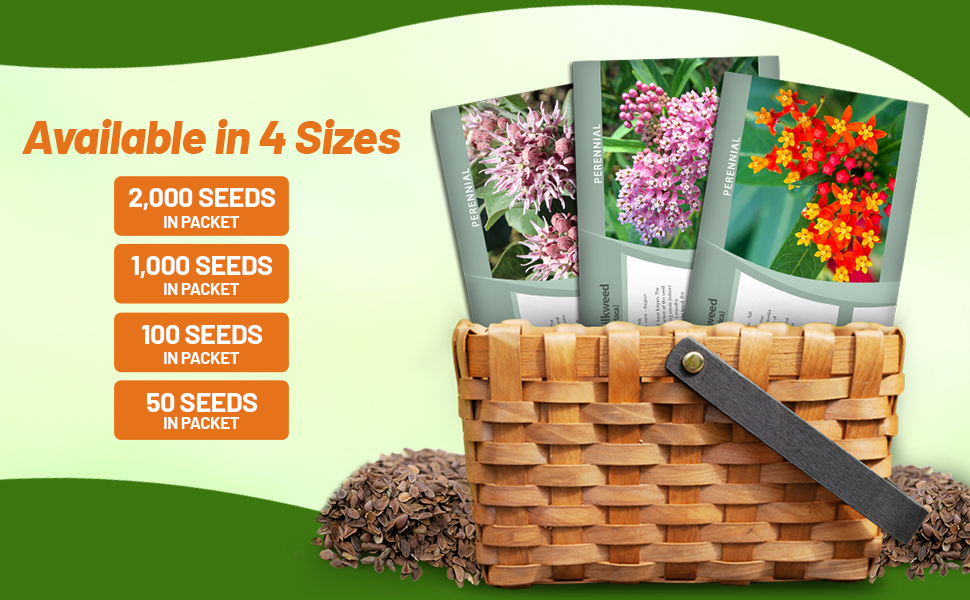



Common Milkweed (Asclepias Syriaca) - This is a bold, attractive plant with broad leaves and large clusters of pink blossoms which is resistant to drought. It can be grown from Milkweed seeds, and it is a must have for the butterfly garden. Asclepias Syriaca draws butterflies with its strong lilac-like fragrance and sweet nectar. Sometimes called Butterfly Milkweed, the perennial is a host plant for Monarch butterfly larva. The eggs are laid on the plant, and the larvae will feed on the plant and mature into a chrysalis. In addition to attracting butterflies, Common Milkweeds are perfect for a naturalized setting. It is very attractive, easily controlled, and easily grown from flower seeds. Common Milkweed has pink flowers and grows to four feet tall. It is native to the Midwest and eastern U.S. It prefers full sun and loamy, mesic soil, but it can tolerate a wide variety of conditions.
Growing Common Milkweed from flower seed is very rewarding. It is appropriate to sow Asclepias seeds outdoors after the frosts of fall have begun. The cold, dormant planting will aid the germination of the seed in spring when temperatures warm. If sowing Common Milkweed seeds indoors or in a greenhouse, refrigerate the flower seed for 2 months before sowing. The cold treatment will help to break the dormancy of the seed.
Common Questions
What are some good companion plants for butterfly weed?
Perennial such as crocosmia, anthemis, kniphofia and agapanthus all go well with common milkweed.
Do I need to fertilize my common milkweed?
No, common milkweed tolerates poor soil so there is no need to fertilize.
Will butterfly weed attract other pollinators besides butterflies?
Yes, bees and hummingbirds also enjoy the butterfly weed plant.
How do I plant common milkweed to attract butterflies?
If your goal is to attract monarch butterflies by planting common milkweed, establish a small milkweed patch with a minimum of six plants. Ensure there is a nearby water source for the butterflies; a birdbath or a large potting saucer filled with water will suffice. It's also beneficial to include other pollinator-friendly plants in a well-rounded butterfly garden.
Why not plant milkweed on the coast?
If you live in a coastal region or near a place where monarch butterflies overwinter, it is recommended to cultivate nectar plants like blazing star and bidens to aid the monarchs during their migration to and from the overwintering spot. Adult monarch butterflies rely on milkweed for reproduction, and the presence of milkweed misleads them into thinking it is a suitable location for breeding, thus disturbing their natural migration pattern.
Will common milkweed take over my garden?
Exercise caution when selecting the planting spot for milkweed. Common milkweed has a tendency to spread aggressively through seeds and rhizomes, potentially outcompeting other plants. Unless you are intentionally cultivating a butterfly garden, it may overpower a mixed border garden. To control its growth, consider planting it in a restricted area or in a backyard section where its spread is acceptable. Despite its robust nature, common milkweed, along with other native milkweeds, is a valuable wildflower and is not classified as a noxious weed or invasive species.
































